Emergency Vets Offer Pet Baths, Radiation Therapy
- Share via
WESTMINSTER, Colo. — Zak the cat protested mildly at first, but Dr. Ann Brandenburg-Schroeder continued to rub more cornstarch and cornmeal into the cat’s gray and white fur to absorb the oil that coated the feline.
It was 2 a.m., and Brandenburg-Schroeder, an emergency care veterinarian, worked steadily until she was relieved by technician Betsy Sylvester, who held, scrubbed and talked to Zak.
Cleaning a petroleum-slicked cat may not qualify as a life-threatening situation, but it is one of a number of jobs that emergency-care veterinarians handle these days. They provide treatment to thousands of animals who need help in a hurry on nights, weekends and holidays.
Many have pets of their own, and they enjoy the challenge and independence their skill allows. Their experience and equipment prepare them to handle situations ranging from gunk-coated cats to Great Danes with pneumonia to victims of fights and poisonings to euthanasia.
Higher Cost
Emergency veterinary care costs more than a routine office visit. Initial fees run about $40 or more.
Dr. Wayne E. Wingfield, chief of emergency medicine and intensive care at the Colorado State University College of Veterinary Medicine and Biomedical Sciences at Fort Collins, is optimistic about the future of emergency care.
“Everywhere I go, emergency care is a very booming business,” Wingfield said during a tour of the hospital’s intensive care unit. “There are a lot fewer kids today and a lot of pets are being used for child substitutes.”
Wingfield, whose staff treated 17,000 small animals in 1986, conducts lengthy seminars on emergency veterinary care in many states and in several foreign countries.
He works at the hospital too. Before he got off duty early one morning, his staff had seen 15 emergency cases. He was also overseeing the care of pets in the intensive care unit.
Radiation Therapy
There was Maggie, a German shorthair-pointer mix from Jamaica Plains, Mass., resting between sessions of radiation therapy. Maggie, who was recuperating from emergency brain surgery, was doing well, Wingfield said.
Spooky Bear, a large black dog from Cheyenne, Wyo., in remission from lymphosarcoma, was being treated for a urinary tract infection.
In a special ICU oxygen unit, Max, a Great Dane from St. Augustine, Fla., was recuperating from pneumonia.
The Colorado State University veterinary school has the most and the best of costly veterinary equipment (an ICU oxygen unit for a single pet runs about $6,000), but private emergency clinics also are well equipped to handle most emergencies.
They also see victims of fights and cruelty to animals.
Dr. Mike Sweeney is the chief veterinarian at Animal Emergency Service Inc. in Lakewood, which handles emergencies for 40 veterinarians. He recently stitched up Chelsey, a small white poodle mauled by two pit bulls at a private kennel.
Puppy Attacked
Dr. Mary Anne Smith of Central Veterinary Emergency Clinic in Denver recently found herself suturing inside the mouth of a 6-week-old chow, which had been attacked by its father for eating out of the wrong food bowl.
Smith has treated many abuse victims. Another life-threatening emergency the clinics see is bloat, a condition caused by excess enzymes in which the dog’s stomach distends.
All emergency care veterinarians say euthanasia is much in demand. It was the euthanasia option that made Brandenburg-Schroeder choose veterinary school over medical school.
“I’m much more comfortable with the ethics of veterinary medicine,” she said. “In veterinary medicine we believe a lot more in the dignity of the patient.”
More to Read
Sign up for Essential California
The most important California stories and recommendations in your inbox every morning.
You may occasionally receive promotional content from the Los Angeles Times.













